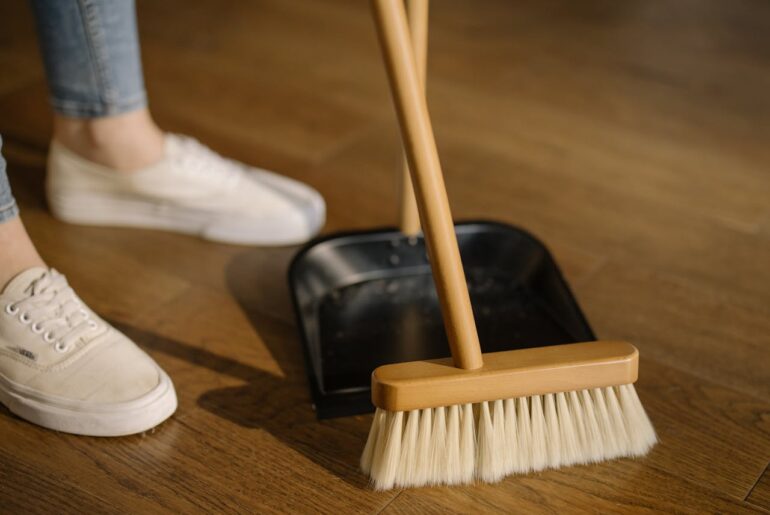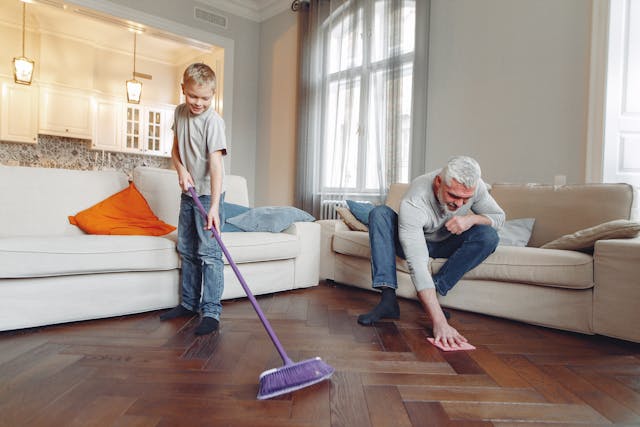Dust is the ultimate freeloading roommate, making life miserable without ever paying rent. It returns regardless of how clean you keep the area, aggravating allergies and inducing discomfort.
The good news is that some straightforward methods exist to keep it out without spending all day cleaning or upsetting your schedule.
The following tips will help, whether you decide to handle it yourself or call in an expert for assistance. So, let us explore some effective ways to reduce dust, making your home feel fresh and welcoming every day.
- Keep Floors Clean
Dust tends to settle on flooring, particularly carpets and rugs, making them a magnet for debris.
The solution? A high-quality vacuum with a HEPA filter can effectively capture even the finest dust particles and keep your floors clean.
Focus on maintaining high-traffic areas regularly. However, do not forget to address the hidden spots under furniture. For hardwood or tiled floors, sweeping and mopping are essential.
If weekly cleaning is too time-consuming, consider assigning these tasks to a housekeeping provider or hiring a cleaner. Their equipment, often of expert standard, can make a significant difference.
- Change Your Bedding Frequently
Unexpectedly, bed linens attract a substantial amount of dust. During sleep, we shed skin cells, providing a feast for dust mites.
Consequently, replace your pillows and bedding weekly to maintain a dust-free haven in your bedroom. To eliminate these pests, launder your bedding in hot water whenever possible. Additionally, wash duvets, blankets, and pillows every few months.
- Invest in Quality Air Purifiers
Although invisible, dust particles constantly float in the air. Using air purifiers is one of the simplest ways to reduce airborne dust. These devices effectively capture dust and allergens before they settle on surfaces.
For the best results, use purifiers with HEPA filters. Place them in frequently used rooms, such as the bedroom and living room.
- Declutter Your Home
You have more locations for dust to gather the more items you own. Clutter not only gives your house more places for dust to accumulate but also makes it seem disorganized.
Organising your belongings into designated storage areas can further minimise dust buildup by reducing the number of exposed surfaces. Thus, think about getting rid of items that you neither use nor need.
Store everything in cabinets rather than leaving belongings out. By following a consistent decluttering schedule—that is, by addressing one area at a time—the process can be less taxing.
- Wipe Surfaces with a Damp Cloth
Instead of removing dirt, dry dusting merely redistributes it. Cleaning with a damp cloth ensures the dust remains on the towel instead of floating away.
Microfibre towels are effective for this as they readily capture and hold dirt. To keep surfaces clean, routinely wipe shelves, electronics, and furniture with a damp one.
- Groom Pets Regularly
While your pets bring lots of joy to your home, they can also contribute to dust buildup through shedding, dander, and skin flakes.
Regular brushing helps keep loose fur under control and minimises the spread of allergens. Bathing your furry companions at appropriate intervals further reduces stray hair and keeps their coats in great condition.
Whenever possible, try to groom them outdoors to contain the mess. To manage pet hair on your furniture, consider using protective covers or specialised tools designed specifically for fur removal.
- Close Windows During High-Pollen Seasons
Opening windows seems appealing for fresh air. However, it allows outdoor dirt, allergens, and dust to enter, especially during spring and high-pollen times. To avoid this, keep your windows closed during these periods.
Use air purifiers to keep the air clean inside. Also, regularly clean window sills and maintain window screens to balance fresh air with dust prevention.
- Clean or Replace Air Filters Regularly
Clean filters are essential for the HVAC system to effectively trap dust particles. Dirty ones allow dust to circulate throughout your home instead of being captured.
Depending on the type of home you have and its environment, change your filters every one to three months.
If this task is too demanding, engage trained individuals to handle it. This ensures your residence remains pristine and the HVAC system operates efficiently.
- Launder Curtains and Dust Blinds
Drapes often act as magnets for dust, yet they are easy to forget during daily cleaning routines.
Every few months, ensure both blinds and curtains receive a thorough refresh. Fabric curtains are usually suitable for machine washing, while blinds can be cleaned with a damp cloth.
For ongoing upkeep, use a vacuum with a brush attachment to remove surface dust. If blinds have stubborn spots, a mild soapy solution applied with a soft cloth works well.
Giving attention to these furnishings enhances air quality and keeps your space feeling fresh.
- Upgrade Your Hoover
It could be time for an upgrade if you still have a basic vacuum cleaner. Particularly those with HEPA filters, modern devices are extremely effective at gathering even the tiniest dust particles.
Furthermore, robot vacuums can help manage daily dust without requiring manual effort. Purchasing a premium-quality hoover will help simplify your cleaning schedule.
- Tackle Dust on Overhead Fixtures
Ceiling fans and light fittings often slip our minds during regular cleaning but can collect a surprising amount of dust.
If left unattended, this dust not only looks untidy but can also float around the room, worsening allergies and lowering air quality.
To safely reach these high spots, use a microfibre duster or an extendable cleaning tool. For stubborn dirt, a slightly damp cloth can lift grime without spreading dust everywhere.
When dealing with chandeliers or intricate light fixtures, compressed air is great for getting dust out of those tiny crevices.
Regularly maintaining these fixtures not only keeps your home looking cleaner but also ensures your lights shine brighter and your fans run more smoothly.
- Control Humidity Levels
Maintaining optimal moisture levels in the home is essential for reducing dust. High humidity breeds dust mites, a common allergen in household dust. Keeping it between 30% and 50% makes mites less comfortable, thus keeping dust at a minimum.
Therefore, use dehumidifiers in basements and bathrooms to reduce humidity. These devices can dampen the air in dry seasons, eliminating dust.
Moreover, utilise exhaust fans in bathrooms and kitchens to exclude moisture-laden air and preserve a balanced indoor temperature.
Leaks and water infiltration need to be fixed right away since standing water can produce mildew and dust mites.
Conclusion
Although handling dust seems like an uphill fight, it does not have to turn into a never-ending struggle.
These simple techniques will greatly reduce the dust in your house, thus enhancing its cosiness and hygiene.
Do not hesitate to contact cleaning services if you are pressed for time or find that managing all of these chores is a hassle. They can help with routine upkeep so you can enjoy a spotless house without having to put in as much work.










Comments are closed.